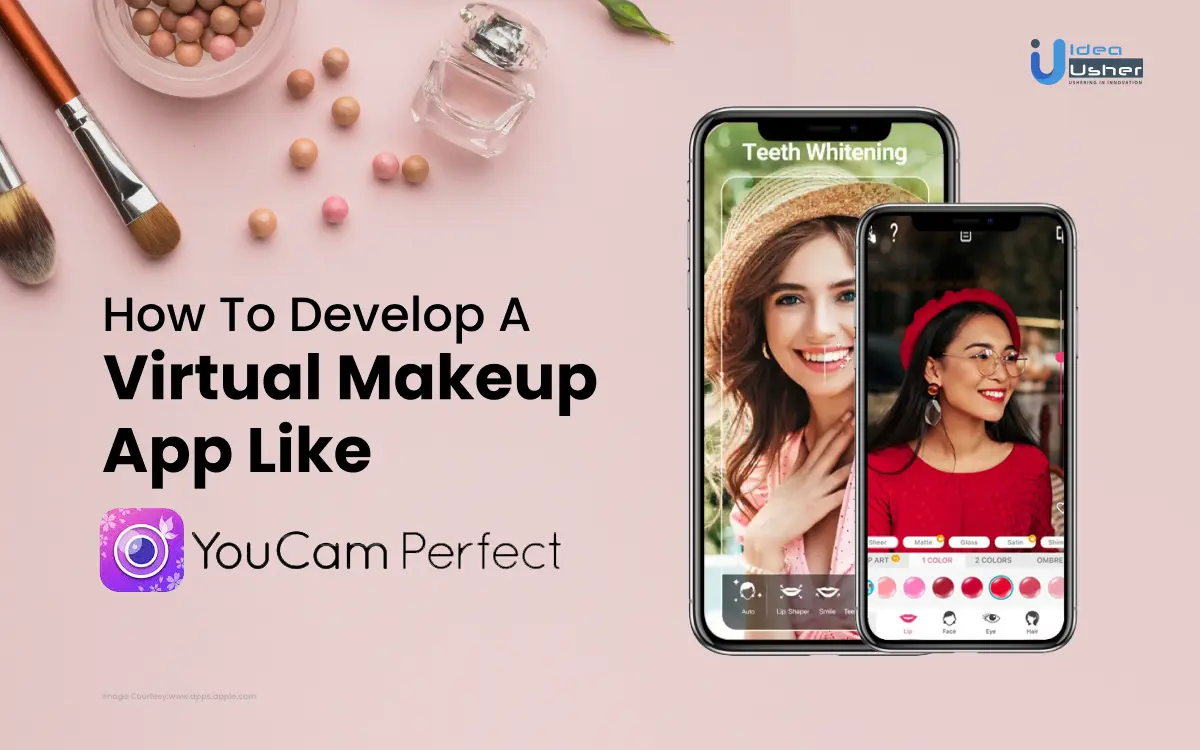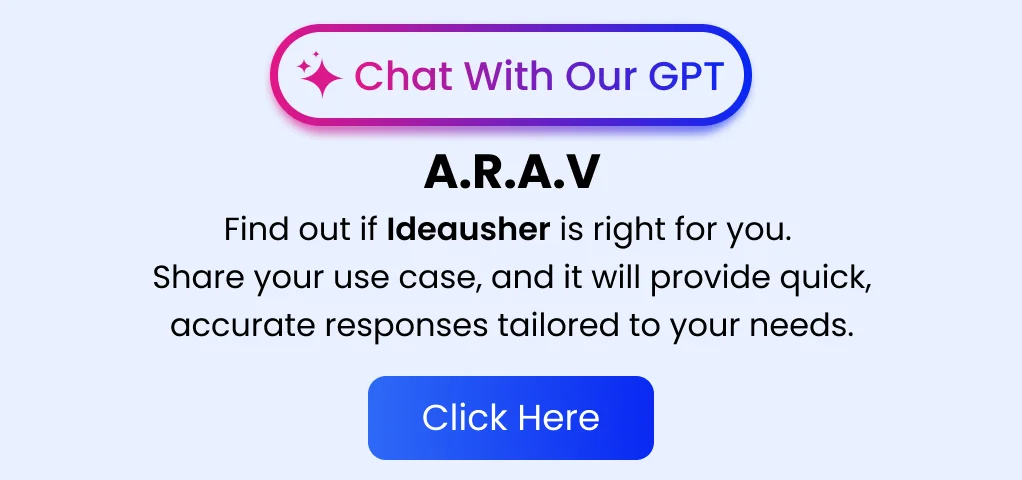Many popular AR makeup apps like YouCam blends the physical and digital worlds, enabling users to try on different makeup products and create personalized looks using their smartphones or other AR-compatible devices.
The demand for innovative and personalized experiences constantly drives the beauty industry. Technologies, including augmented reality, have emerged in a transformative shift, revolutionizing how customers interact with cosmetics. AR-enabled virtual makeup applications allow customers to try different styles and shades before making a final purchase of makeup products.
The makeup industry has been constantly growing over decades, indicating a better opportunity for investors seeking to enter and make profits in this market with AR-enabled makeup application development.
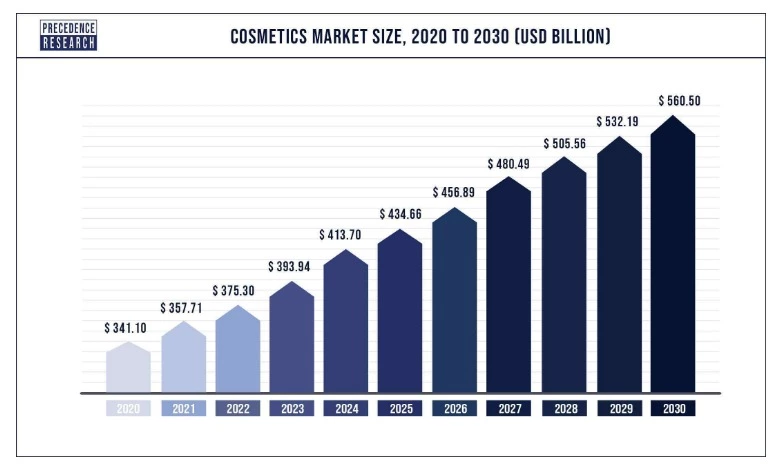
Credits: Precedence Research
Explore the process of AR makeup app development, including the underlying technology, key features, and the top players of the AR makeup app.
What Is A You Cam Makeup App?
A mobile application that leverages the power of augmented reality technology and enables users to try virtual makeup experiences with virtual makeup experience. The users can use their device camera or upload photos to try different cosmetics virtually through AR-based makeup apps.
The AR-based virtual makeup apps utilize computer vision and facial tracking algorithms to detect and map the user’s special features and apply virtual makeup products such as eyeshadow, lipstick, blush, foundation, and more.
The application allows users to virtually try on different hair, makeup, and accessory colors. The YouCam app utilizes semantic networks to determine and change the right side, such as hair or lips.
The primary goal of YouCam makeup is to engage its users by enabling them to modify their appearance using various virtual makeup editing tools.
How Virtual AR Makeup App Works?
The AR Makeup mobile app leverages the power of augmented reality technology and computer vision algorithms to enable its users to try different makeup products virtually.
Here is the general overview of the working of AR makeup mobile applications.
1. Face Detection and Tracking
AR-based virtual makeup apps utilize the device camera or uploaded photos to detect and track the user’s face. There is a utilization of computer vision algorithms for analyzing facial features, including skin tone, to create a digital version of the face.
2. Facial Mapping
After detecting and tracking the users’ facial features, the app maps the virtual makeup products onto the user’s face. The process involves aligning virtual makeup with the user’s eyes, lips, cheeks, and other relevant areas.
The mapping also ensures that the virtual makeup accurately follows the shape and movement of the user’s face.
3. Real-time Visualization
Based on the user’s facial features and expressions, the app updates the virtual makeup accordingly. This enables users to see the virtual makeup in motion from different angles, providing them with a more realistic preview of their final makeup look.
4. User Interaction
The AR-based makeup application offers interactive features for users to enhance their digital makeup experience. Moreover, users can select different shades, products, and styles from a digital catalog.
Users can apply makeup in specific areas and can experiment with different combinations.
5. Color and Texture Rendering
The users can render their makeup looks by adjusting various factors, including lighting conditions, color accuracy, skin tone, etc.
Moreover, the app also enables its users to adjust the textures, colors, and opacity of their virtual look to modify their desired look even further.
6. Additional Features
Several other features augmented reality-based virtual makeup apps can offer to their users, such as makeup tutorials & tips, social sharing capabilities to showcase their makeup looks, integration with cosmetic brands to enable customers to buy makeup products, etc.
Based on market research and competitor analysis, the developers can incorporate various other features to enhance their app experience and stay competitive in the makeup industry.
Must Have Features For Virtual Makeup Apps
Virtual makeup apps enable their users to try on different looks and experiment with various products without physically applying them. Here are some must-have features you can build and implement to your digital platform to create a successful virtual makeup app.
1. Face Mapping and Tracking
Face tracking and mapping feature enables users to identify and align their facial features properly, ensuring that the makeup they have applied virtually is realistically precise and accurate.
2. Realistic Makeup Application
Offer your users a wide range of products, including lipstick, foundation, blush, and many other virtual makeup items. However, ensure that those virtual products should be realistic and seamless and mimics the effect of real makeup products on the users’ face.
3. Customization and Personalization
The virtual makeup app should allow users to customize and personalize their virtual makeup experience, including the intensity of the makeup, trying different colors and shades, and experimenting with other virtual makeup products to create their desired look.
4. Product Recommendations
If you plan to sell makeup items to your platform, implementing a product recommendation feature would be worth it. By suggesting various makeup products, your users can discover new brands and make purchases, which can help you increase your business revenue by taking profitable commissions on each sale.
5. Social Sharing
The social sharing feature will enable users to share virtual makeup with friends, followers, and other online communities. Overall, this feature will foster user engagement and create buzz around the app.
6. Tutorials and Guides
Incorporate various makeup tutorials, guides, and tips to help users to create their desired look through your AR-based virtual makeup app. Providing step-by-step instructions or video tutorials will help users learn new techniques and enhance their look.
7. Augmented Reality (AR) Filters
Applying augmented reality filters will help users to try various makeup effects on a real-time camera feed virtually. These filters can be interactive and fun, allowing users to try creative and unique makeup styles.
8. Integration with E-commerce Platforms
The eCommerce functionality will be helpful if you are willing to sell different makeup products among your users. This feature simplifies purchasing process, making it more convenient for users to buy makeup products they would like to apply on their face.
9. Offline Mode
Allow your users to access your AR-based online platform even without an internet connection by incorporating offline mode into your app. Offline mode will help users access all the app features through which they can try different virtual makeup looks.
However, based on market research and competitor analysis, you can add more features to your AR-based virtual makeup app to facilitate an enhanced experience among your app users.
Steps To Develop AR Makeup App
There are several key steps required to develop an AR makeup app. Here is a general overview of the process.
1. Define the App’s Goals and Target Audience
Identify your target audience and project scope for building your app. Define the specific features and functionalities you want to incorporate into your app.
2. Conduct Market Research
Conducting market research is another crucial aspect you need to consider when building your augmented reality-based makeup app. Market research will help you identify the unique selling points of your competitors and will help you identify the gap that you can fulfill by providing unique features to your app.
3. Create App Concept and Design
This stage will include designing the UI/UX part of your app. Consider creating mockups and wireframes to create the app’s functionality and layout of your app.
4. Gather Makeup Assets
The makeup assets will help your users to virtually modify their looks virtually by utilizing various makeup elements such as shades, textures, images, etc. Consider collaborating with makeup brands and professionals to acquire high-quality digital assets.
5. Develop Face Tracking and Mapping Technology
The following technologies will enable users to detect and track their facial features, which would be helpful for them to properly align their faces with the virtual frame.
6. Implement Makeup Application Algorithms
Consider developing algorithms to generate a realistic makeup simulation on the users’ faces. The algorithms should include texture mapping, color blending, lighting, and shading to offer a realistic view of the virtual makeup experience.
7. Build the App’s Backend
The back-end development is a crucial aspect of supporting the features and functionality of AR makeup applications. The back end should include databases for product catalogs, user profiles, and integrations with e-commerce platforms ( if you are planning to sell makeup products from your platform).
Consider developing the MVP version of your AR-enabled makeup app to minimize the app development budget, effort, and time.
8. Create User Accounts and Profiles
The user profile and account will enable users to manage their accounts, preferences, and access to saved makeup looks. Moreover, these features will enable users to create their unique identity among your app users.
9. Integrate Social Sharing and E-commerce Features
Develop and implement e-commerce and social sharing functionality for your AR-based makeup app. Social sharing will enable users to share their makeup looks across various social media platforms.
Moreover, the e-commerce functionality will enable users to purchase makeup products that you are willing to sell on your platform.
10. Test and Debug
Testing and debugging are crucial aspects to identify any glitches, bugs, and performance issues and fix them as soon as possible. The app testing will involve testing your app working across different devices, operating systems, and screen resolutions to ensure responsiveness and compatibility.
11. Deploy and Launch
After app testing, the next step is to deploy and launch your app across your preferred platform, such as iOS & Android. Consider following their submission guidelines and the requirement to avoid any hindrance while publishing your app.
12. Gather User Feedback and Iterate
Collecting and analyzing user feedback and reviews will enable you to identify new features, ideas, and areas of improvement. Update the app regularly to provide better app experiences on each update.
Moreover, try to prioritize app performance, user experience, and intuitive navigation throughout the app to enhance the app experience through your digital AR-based makeup platform.
Top 5 AR Makeup Apps
Explore the best AR makeup app enabling their users to try different virtual looks with various filters and makeup accessories.
1. YouCam Makeup
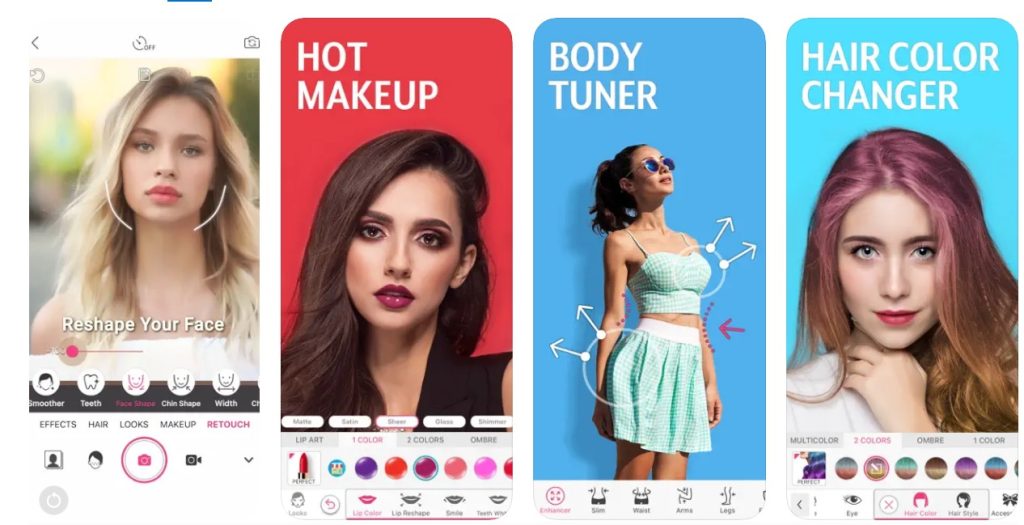
A well-known AR cosmetics software with a wide variety of makeup styles, effects, and virtual try-on. YouCam Makeup offers facial tracking technology, a huge selection of beauty items from numerous brands, and a real-time virtual makeup application.
- Founded in: 2014
- Owned by: Perfect Mobile Corp
- Available on: Android & iOS
- App Downloads: 100M+
- App Ratings: 4.4
- Headquarters: Taipei, Taiwan
2. Sephora Virtual Artist
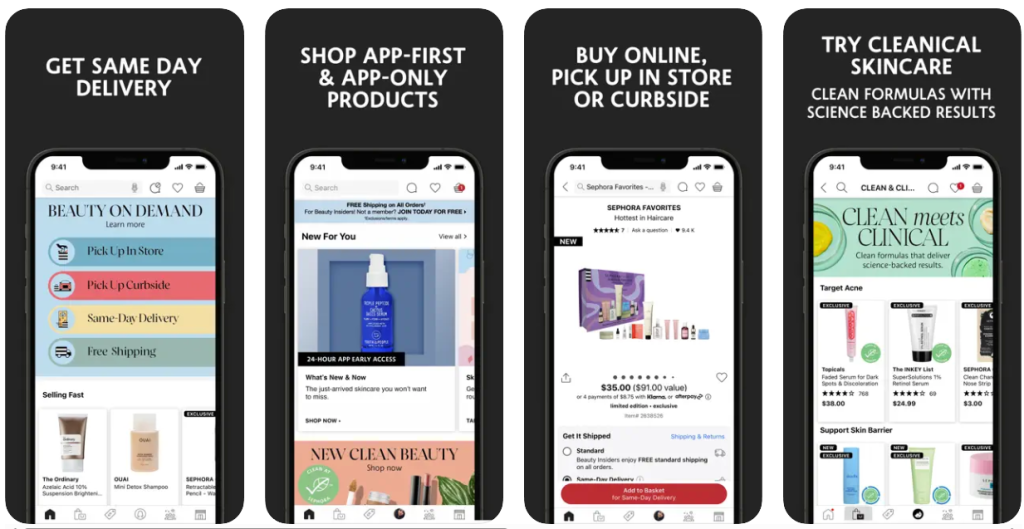
The platform enables users to test out a variety of cosmetics, such as eyeshadows, lipsticks, and foundations. Based on customer preferences, the app recommends products using accurate facial mapping technology.
- Founded in: 2016
- Owned by: Dominique Mandonnaud
- Available on: Android & iOS
- App Downloads: 1M+
- App Ratings: 4.2
- Headquarters: Limoges, France
3. Mary Kay Virtual Makeover
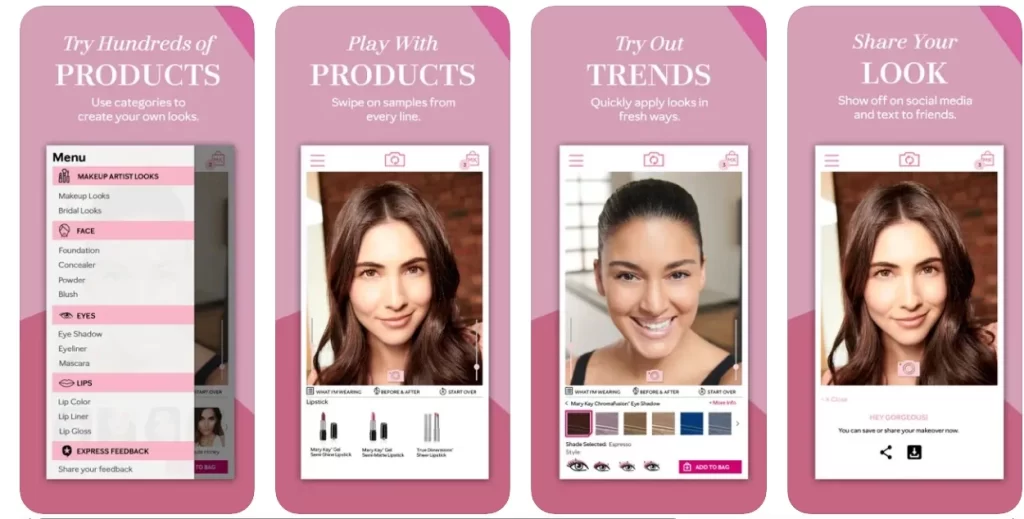
An AR makeup software that the Mary Kay cosmetics company developed. The platform allows its users to experiment with numerous styles and tests on various cosmetics items.
Moreover, the Mary Kay Virtual Makeover app provides step-by-step makeup instructions and offers personalized recommendations depending on the user’s skin tone.
- Founded in: 1963
- Owned by: Mary Kay Ash
- Available on: Android & iOS
- App Downloads: 100K+
- App Ratings: 3.0
- Headquarters: Dallas, Texas, USA
4. Perfect365
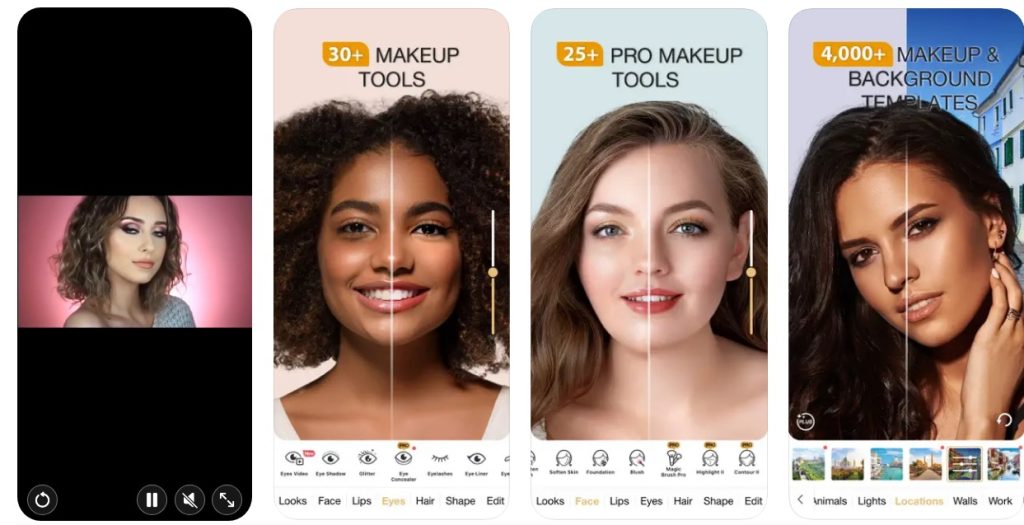
Perfect365 is an AR makeup app that enables users to experiment with different makeup looks, hairstyles, and accessories. It provides various makeup styles and allows customization to match individual preferences. The app also features social sharing capabilities and offers makeup tutorials and tips.
- Founded in: 2011
- Owned by: Deng Hui
- Available on: Android & iOS
- App Downloads: 50M+
- App Ratings: 4.3
- Headquarters: Hangzhou, Zhejiang, China
5. MakeupPlus
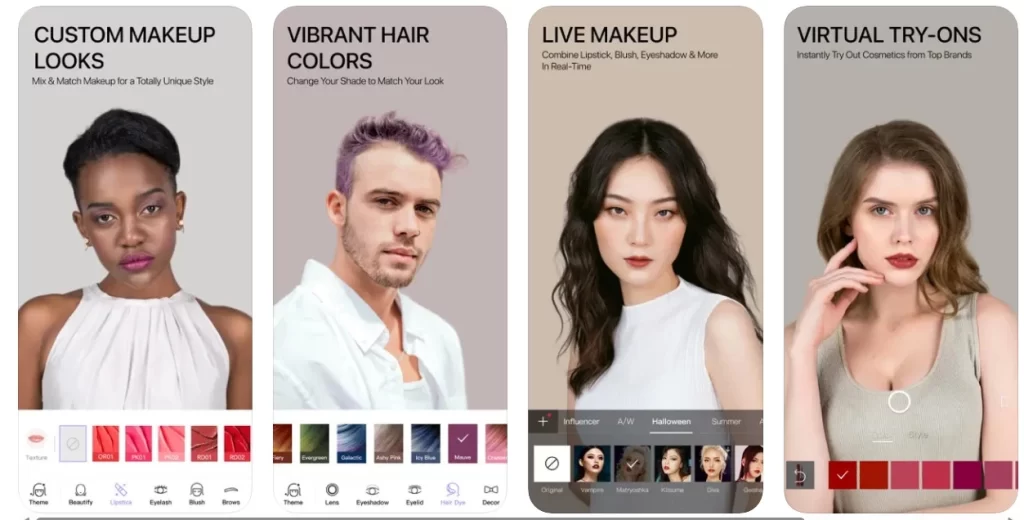
The well-known augmented reality (AR) beauty app provides a broad range of virtual makeup options, such as foundation, blush, eyeshadow, eyeliner, and more. Moreover, the MaekupPlus app offers personalization options and a realistic makeup application where users can test out makeup looks developed by celebrities and beauty influencers.
- Founded in: 2008
- Owned by: MeituEve
- Available on: Android & iOS
- App Downloads: 50M+
- App Ratings: 4.2
- Headquarters: Xiamen, China
There are many other applications available that you can explore when doing market research or computer analysis to identify the top features that you can implement in your app.
Technical stack For AR Makeup App Development
When developing an AR makeup app, the choice of the technical stack depends on various factors such as the targeted platform (iOS, Android), desired features, development expertise, and specific requirements.
Here are some common technologies and tools used in the development of AR makeup apps:
1. AR Development Frameworks
- ARKit (for iOS app development)
- ARCore (for Android app development)
- Vuforia
- Wikitude
2. Programming Languages
- Swift (for iOS app development)
- Java or Kotlin (for Android app development)
- C# (if using Unity for cross-platform development)
3. Computer Vision and Image Processing
- OpenCV
- Core Image (for iOS)
- Android Camera API (for Android)
4. 3D Modeling and Animation
- Unity 3D (for cross-platform development)
- SceneKit (for iOS)
- OpenGL or Vulkan (for Android)
5. Backend Development
- Server-side technologies such as Node.js, Python, or Ruby
- RESTful APIs for data management and integration
- Database management systems like MySQL, PostgreSQL, or MongoDB
6. Cloud Services
- Cloud storage services like Amazon S3 or Google Cloud Storage for storing makeup assets and user data
- Cloud computing platforms like AWS or Google Cloud for processing and analyzing data
7. Augmented Reality Tools and Libraries
- AR Foundation (Unity)
- ARKit (iOS)
- ARCore (Android)
8. UI/UX Design and Prototyping
- Sketch, Adobe XD, or Figma for UI/UX design
- InVision or Marvel for interactive prototyping
9. Version Control and Collaboration
- Git or SVN for version control
- GitHub, Bitbucket, or GitLab for code repository hosting and collaboration
10. Testing and Debugging
- Testing frameworks like XCTest (for iOS) and Espresso (for Android)
- Debugging tools provided by the respective development platforms
Remember that the selection of the technical stack may vary based on the specific project requirements. It’s advisable to consult with your development team or experts in the field to determine the most suitable technologies for your project.
Here is a complete guide on hiring app developers in 2023.
Conclusion
AR makeup application offers numerous advantages to both businesses and users. Businesses can invest in AR makeup app development and tap into this profitable market.
In addition to gathering valuable data insights from their AR-enabled digital makeup platforms, businesses can enhance their brand visibility and access better conversion rates and increased sales.
On the other side, users can benefit from the convenience of AR makeup apps as they can experiment with different virtual makeup products and can visualize their desired look in real-time. However, developing an AR-based virtual makeup application requires enormous expertise across different domains such as programming, UI/UX design, market research, etc.
Therefore partnering with a reliable app development company is a great way to build your AR-enabled virtual makeup application starting from scratch.
Work with us if you are looking for an app development firm to help you, from strategizing your business to developing and deploying your AR-enabled virtual makeup application to your targeted market.
Work with Ex-MAANG developers to build next-gen apps schedule your consultation now
Email:
Phone:
(+1)732 962 4560
(+91)859 140 7140
FAQ
Q. What is the use of AR in the beauty industry?
A. Augmented reality apps in the beauty industry enable customers to try different shades and styles before making a final purchase of makeup products.
Q. Is there an app to put makeup on a picture?
A. Perfect 365, YouCam Makeup, Sephora Virtual Artist, and Mary Kay Virtual Makeover are some of the best applications for putting makeup on a picture.
Q. How to Create an AR Makeup Try-On Tool?
A. AR makeup try-on tool can be created by following the given steps: define the app’s goals and target audience, conduct market research, create app concept and design, gather makeup assets, develop face tracking and mapping technology, implement makeup application algorithm, build the app’s backend, create user accounts and profiles, integrate social sharing and e-commerce features, test and debug, deploy and launch, gather user feedback and iterate
